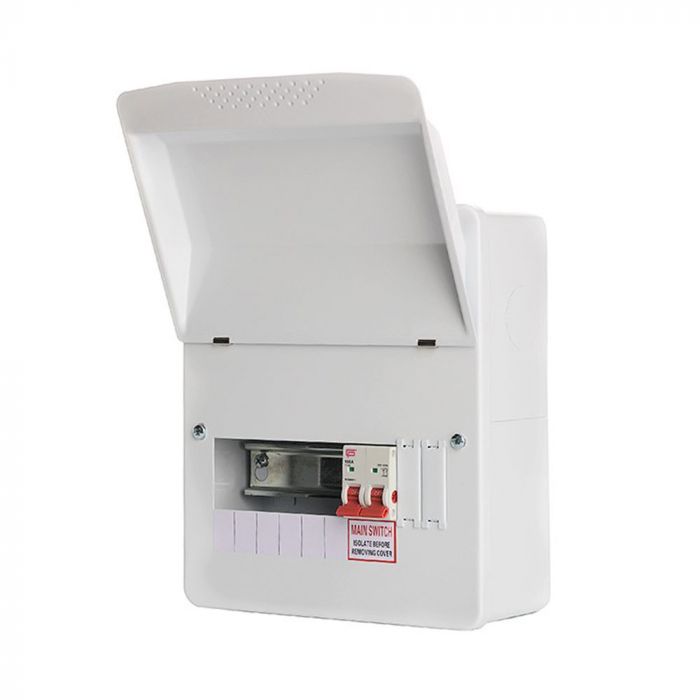Understanding the Conveniences of RCBO CONSUMER UNITS for Modern Homes
Understanding the Conveniences of RCBO CONSUMER UNITS for Modern Homes
Blog Article
The Function of Consumer Units in Effective Energy Monitoring Solution
Customer systems are indispensable to effective energy management systems, offering as the primary distribution factors for electric power within structures. The introduction of smart innovations has actually even more boosted their capability, permitting for real-time data surveillance and nuanced energy intake analysis.
Comprehending Customer Units

Recognizing the function of customer units begins with acknowledging their essential feature in guarding electric systems. By isolating faults within specific circuits, consumer systems protect against prevalent blackouts and prospective fire risks. This isolation is achieved via the usage of breaker that trip or fuses that impact when a fault is found, therefore reducing off the electrical flow to the affected circuit.
Additionally, customer systems assist in the orderly distribution of power, boosting the effectiveness of energy usage. They enable the organized monitoring of electric loads, which can be especially crucial in business and commercial setups where need can fluctuate dramatically. Properly maintained consumer units add to the long life of electrical systems and assist in minimizing downtime triggered by electric failures, ultimately supporting the smooth procedure of energy-dependent facilities.
Smart Technologies Integration

An essential benefit of wise consumer devices is their capability to leverage progressed algorithms and machine learning for anticipating analytics. This permits preemptive modifications based on usage patterns, weather report, and other variables, considerably raising overall effectiveness. Smart customer devices help with demand reaction programs, where power usage can be dynamically adjusted throughout top durations to support the grid and decrease costs.
The combination of renewable energy resources, such as solar and wind, is also streamlined through smart consumer units. By wisely handling the intermittency of these resources, these systems make certain a well balanced and reputable energy supply. Furthermore, clever customer units boost customer interaction by offering thorough understandings and push-button control capabilities through mobile applications, fostering a much more proactive method to energy preservation and sustainability.
Surveillance Power Consumption
Structure on the abilities of smart technologies assimilation, checking power usage ends up being an essential emphasis within power monitoring systems. By leveraging innovative metering facilities (AMI), real-time information on power use can be accumulated at granular levels, offering useful understandings right into intake patterns and peak need durations.
Smart meters and Net of check my site Points (IoT) devices play an essential duty in this surveillance procedure. These devices can track energy usage in real-time, transferring information to central systems for evaluation.
The combination of these technologies not just equips consumers with in-depth details concerning their power use yet additionally sustains energy service providers in handling lots circulation better. Ultimately, constant and exact monitoring is important for achieving power efficiency, expense savings, and sustainability objectives within power administration systems.
Optimizing Home Appliance Usage

One effective method includes determining peak and off-peak hours to move energy-intensive activities, such as laundry or dishwashing, to times when power need is reduced. This not only lessens strain on the grid yet likewise maximizes reduced energy tariffs. In addition, incorporating machine discovering formulas enables for anticipating maintenance, making certain appliances operate at optimal efficiency and prolonging their lifespan.
Power monitoring systems can likewise incorporate user-specific preferences and actions to customize home appliance use timetables. For instance, wise lights systems can readjust illumination based on occupancy and all-natural light schedule, while cooling and heating systems can preserve convenience levels without extreme power usage.
Supporting Sustainability
Promoting sustainability within power monitoring systems entails not just boosting efficiency but likewise promoting ecologically accountable methods. Consumer devices are important to this procedure, as they give real-time data and control devices that allow customers to keep an eye on and minimize their power consumption. By leveraging sophisticated innovations, customer devices can recognize energy-saving opportunities and facilitate the combination of sustainable power resources like solar and wind power.
One important facet of promoting sustainability see it here is educating consumers on the benefits of liable power use. Via comprehensive insights provided by customer systems, users can make informed choices that lessen their carbon footprint. For example, these devices can suggest ideal times for running high-energy appliances based on grid demand and sustainable power schedule, thus lowering dependence on fossil fuels.
Moreover, customer units support the fostering of smart grid modern technologies, which enhance the general efficiency and integrity of energy circulation. By making it possible for two-way interaction between consumers and utility companies, these systems can dynamically get used to energy demands, lowering waste and promoting making use of sustainable energy practices.
Final Thought
Consumer devices, as integral elements of energy management systems, browse around this site significantly boost electrical safety and effectiveness within buildings through circuit security and smart modern technology assimilation. Furthermore, the unification of renewable power resources promotes lasting techniques, contributing to minimized overall power usage and lower carbon impacts.
Breakthroughs in smart modern technologies have reinvented the capacities of power management systems, especially via the assimilation of smart consumer systems.Structure on the capabilities of wise modern technologies assimilation, keeping an eye on energy usage becomes a vital emphasis within power monitoring systems.Reliable device use optimization is a crucial component of energy management systems, aiming to enhance efficiency and reduce unnecessary energy consumption.Consumer devices, as integral components of energy management systems, considerably improve electric security and performance within structures via circuit defense and clever modern technology integration. Additionally, the consolidation of renewable energy sources promotes sustainable practices, contributing to minimized total power intake and reduced carbon impacts.
Report this page